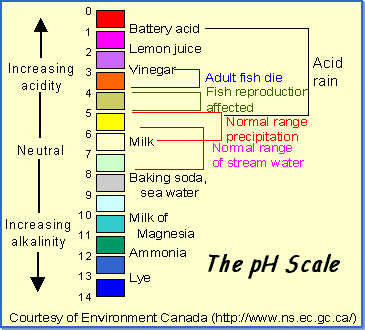Water and Acid - pH
pH is a measure of how acid/base water is. The range goes from 0 - 14, with 7
being neutral. pHs of less than 7 indicate acidity, whereas a pH of greater than
7 indicates a base. pH is really a measure of the relative amount of free hydrogen
and hydroxyl ions in the water. Water that has more free hydrogen ions is
acidic, whereas water that has more free hydroxyl ions is basic. Since pH can be
affected by chemicals in the water, pH is an important indicator of water that
is changing chemically. pH is reported in "logarithmic units," like
the Richter scale, which measures earthquakes. Each number represents a 10-fold
change in the acidity/basicness of the water. Water with a pH of 5 is ten times
more acidic than water having a pH of six.
Pollution can change a water's pH, which in turn can harm animals and plants
living in the water. For instance, water coming out of an abandoned coal mine
can have a pH of 2, which is very acidic and would definitely affect any fish
crazy enough to try to live in it! By using the logarithm scale, this
mine-drainage water would be 100,000 times more acidic than neutral water
-- so stay out of abandoned mines.



